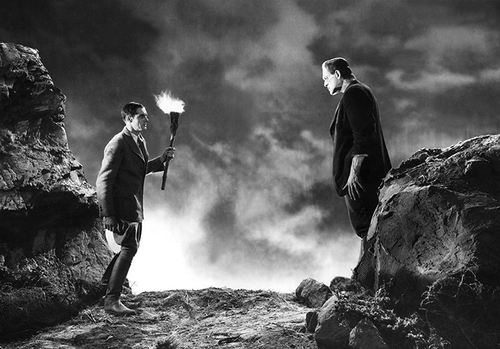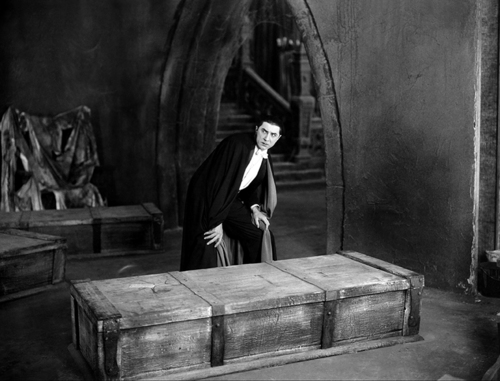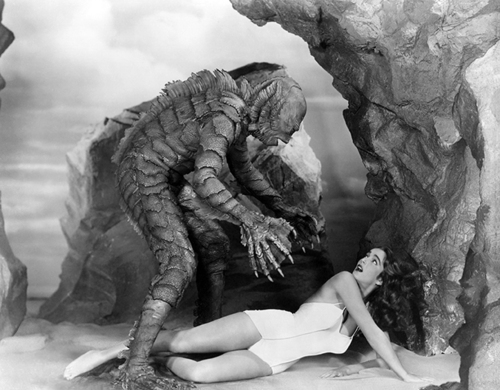Universal lets loose its monsters
PostED ON OCTOBER 7, 2016 AT 2PM
It is a hypothesis as hazardous as it is suggestive - the possibility of resurrecting a stitched up body, electrodes jutting from the forehead, glassy eyes fixed on the sky to snatch the magical electricity of a thunderstorm… To recapitulate: we need a stock market crash, a world in crisis, unemployment and suicide; and on the other side of the Atlantic, a mass exodus, because it's not convenient to be Jewish in the Europe of the day, while another storm is brewing… Allow these extraordinary circumstances to arise, and, in sunny Hollywood California, from 1930 to 1940, mythical monsters will come lurking on the screen in black and white… A vampire in a velvet cape (black with red lining, we assume), an electrified creature who makes his creator a God, a werewolf partial to favors, an Egyptian prince in strip-bandages, emerging from his coffin, a body that scientifically drops off the sight radar, and so on. Monsters emerge from the past whilst unconscious scholars explore dangerous "advancements." …Presumably the same savants who are already tinkering with the atom...

It seems that periods of unrest are conducive to horror movies: we dance at the Liberation, we laugh at the Armistice, but on the brink of war, when misery is seeping through to the masses, we open the escape hatch by watching "evils "worse than the known realities. Someone had the astute intuition at Universal (incidentally, not the biggest of studios at the time, and not unaffected by the crisis). Who? Carl Laemmle, the studio mogul? Or was it his son, "Junior" Laemmle, roundly ridiculed for the flagrant nepotism that catapulted him to studio leadership from his twenty-first birthday? Nevertheless, being both cultivated and quite fearless, Junior decided to send out one monster flick after another: Dracula by Tod Browning, James Whale's Frankenstein (both in 1931), The Mummy by Karl Freund (1932), The Invisible Man by James Whale (1933), The Bride of Frankenstein, again, by James Whale (1935) - a dreamlike string of successes.
Where does this fantastic universe of excessively elaborate sets come from - mansions with thick cobwebs, a watchtower in near ruin that houses the lab of a demiurges' clandestine creations? …Probably from Germany. James Whale saw and loved The Cabinet of Dr. Caligari (Robert Wiene, 1919), Junior Laemmle visited Ufa in Berlin, Karl Freund was a direct product of the studio, as former chief operator for Lang and Murnau. Expressionism was viewed as an unsettling but arbitrary virus carried by migrants from the era. Some arrived already haloed with prestige, welcomed by the Hollywood industry; others had fled the outbreak of terror and had to start from zero. As Bertrand Tavernier has often said, Europe brought to America "an aesthetic of doubt, of chiaroscuro, of the lurking threat, whereas American cinema represented self-affirmation, bathed in bright light." Unrest, terror, unrelenting horror, an unstoppable will for destruction… filled the movies to the brim.

They had their stars, which were only recently American: Hungarian Bela Lugosi was not the studio's first choice to bring the vampire to the big screen - they spent ample time seeking a younger, more dashingly handsome - or simply more German - count; Conrad Veidt declined the role, finding his English too poor. But the film's success would make the Magyar megalomaniac immensely popular - and eventually a prisoner of the Count - sleeping in a coffin. Lugosi declined the offer to play the mute creature of Dr. Frankenstein, so instead, James Whale chose William Henry Pratt, AKA Boris Karloff, near London. The gentle giant was "tortured" by Jack Pierce's makeup sessions, a sacrifice required to produce the desired effect we're familiar with.
Dracula, Frankenstein (a metonymy transposing the name of its creator to the creation), the Mummy, the Invisible Man, etc. had such success bestowed upon them, film after film… to the extent that their legends suffered from over-exposure. The 1940s saw the rise of the semi-parodies - America at war needed to laugh at what once frightened them. Ten years later, Universal would rekindle the flame of fear: the Cold War being the thorn in the side of a growing nation, making it only logical to return to fright.
Creature from the Black Lagoon (1954) - a reptilian monster-man that wreaked havoc at the depths of his prehistoric lagoon - was added to the bestiary. Jack Arnold, a great and underestimated filmmaker, was greatly helped by the studio makeup team, who gave the creature throbbing gills and large, lidless eyes, enabling him to admire, from every angle, the beautiful Julie Adams, bubbling in the clear water… It was the genesis of a revelation: the "beast" would not have been so violent without the malice of man. The stingy credits did not bother to mention the two guys who donned the scaly suits - one in the water, the other on land. Moral of the story: true monsters only create stars when they are lowlife critters.

Adrien Dufourquet
Restrospective program: > Universal Monsters

